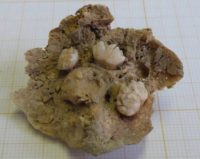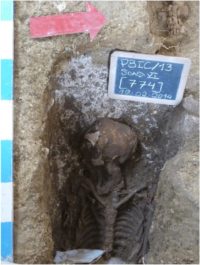I can’t believe it’s been almost four years since my last ovarian teratoma story. Just goes to show how rarely they survive in an archaeological context. Well, if there’s a better way to usher in a new year than with a centuries-old calcified mass of tissue and teeth, I don’t know of it.
 Today’s teratoma was discovered in the cemetery of the Church and Convent of Carmo in Lisbon, Portugal, a private burial ground for the religious of the order and its (largely middle class) patrons. It was in use from the 15th century until the 1755 Lisbon earthquake shut it down for good. The cemetery was only recently excavated by Lisbon Archaeological Centre archaeologists in advance of an urban renewal project. During its second dig season in March of 2011, the LAC team encountered skeletal remains with a large calcified mass in the pelvic area. Only the lower half of the body could be recovered at that time. The rest was unearthed in February of 2014, making it possible for all the remains of the individual to be studied.
Today’s teratoma was discovered in the cemetery of the Church and Convent of Carmo in Lisbon, Portugal, a private burial ground for the religious of the order and its (largely middle class) patrons. It was in use from the 15th century until the 1755 Lisbon earthquake shut it down for good. The cemetery was only recently excavated by Lisbon Archaeological Centre archaeologists in advance of an urban renewal project. During its second dig season in March of 2011, the LAC team encountered skeletal remains with a large calcified mass in the pelvic area. Only the lower half of the body could be recovered at that time. The rest was unearthed in February of 2014, making it possible for all the remains of the individual to be studied.
Osteological examination confirmed the individual was a woman between 5″1 and 5″3′ in height who was more than 45 years old when she died. In her pelvic girdle was a calcified mass that was the same color and texture of her bones. It is small, 1.5″ in length and only a sliver more than that in diameter. Teeth were visible embedded in the inner surface of the base. Researchers cleaned the mass thoroughly and were able to observe irregular, erratic bone formation on the outer and inner surfaces and five malformed quasi-teeth. Four are molar-like, one canine-like. One of the molariform teeth is more malformed than the others, missing any semblance of a root. An X-ray of the teratoma found no further bone structures in the mass.
 There’s no way of knowing with certainty whether the mass had an impact on her health or her cause of death. Teratomas are almost always benign and can easily go undiagnosed because they’re not really bothering anyone. Occasionally their shape, size and location can result in organ shifts, infections, anemia, but there is no evidence at all on the bones — no lesions or deformations.
There’s no way of knowing with certainty whether the mass had an impact on her health or her cause of death. Teratomas are almost always benign and can easily go undiagnosed because they’re not really bothering anyone. Occasionally their shape, size and location can result in organ shifts, infections, anemia, but there is no evidence at all on the bones — no lesions or deformations.
While there is no osteological evidence of what did claim her life, she was buried under a thick layer of lime, unusual in that context. If the people who put her in the grave covered her with lime, it’s likely they thought she had died of an infectious disease.